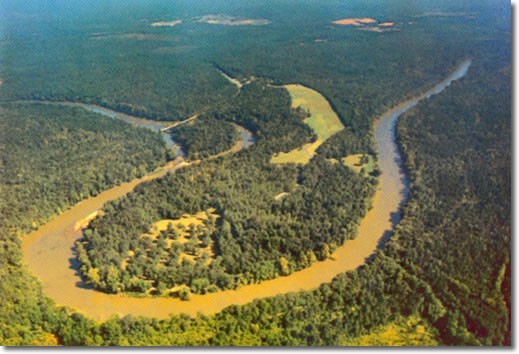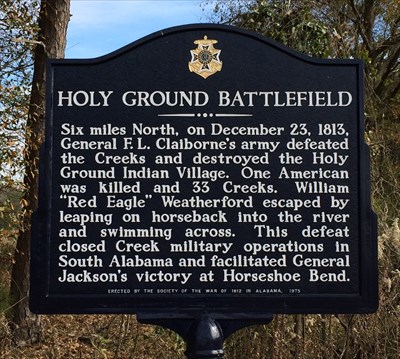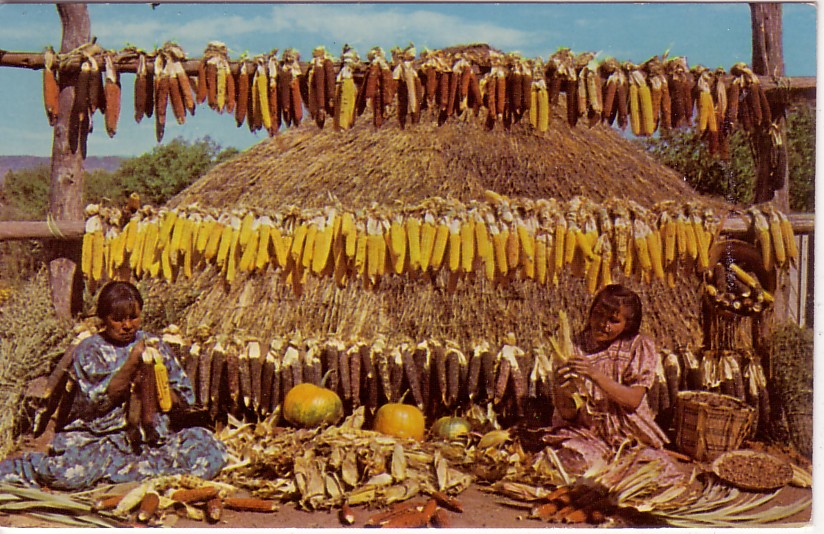The Battle of Horseshoe Bend Was Huge for Alabama
The Battle of Horseshoe Bend was considered one of the best military victories for the United States for one very distinct reason.
The reason was simple; it effectively ended the Creek Indian Wars that had lasted for several years and was one of the bloodiest wars in US history at the time.
In this famous battle that was led by Andrew Jackson, more than 800 Red Stick warriors were killed in the battlefield, as well as the surrounding river.
 Overhead View of Horseshoe Bend
Overhead View of Horseshoe BendThe Chief of the Red Stick faction was severely wounded but was not killed.
He was taken prisoner along with 350 Upper Creek women and children in this fierce battle.
This historic battle is preserved by the National Park Service as the Horseshoe Bend National Military Park, which is located near Dadeville Alabama.
The History of the Battle of Horseshoe Bend
 Horseshoe Bend National Military Park In Alabama
Horseshoe Bend National Military Park In AlabamaThe Battle of Horseshoe Bend has an extremely interesting history, as it not only helped to shape the state of Alabama; it also helped to shape America.
To fully understand just how important this battle was to Alabama as well as the country, it helps to understand its history.
The Creek War was much like our Civil War, as it started when two major factions of the Creek Nation clashed over their beliefs,
The first faction, the Upper Creek “Red Sticks”, was in total disagreement with the Lower Creek faction, who wanted to help the white settlers.
The Red Sticks wanted nothing to do with the white settlers, and as a result, they aligned with British traders in Florida as well as the Spanish Government.
These two enemies of the United States provided the Red Stick faction with arms and supplies to help fight the white settlers.
They did this because of their shared interest in preventing expansion of these setters in the surrounding areas.
The United States in turn, formed an alliance with the Lower Creek faction, as well as the Choctaw and Cherokee Nation Indian Tribes.
It is considered by most historians to be part of the War of 1812, for two reasons.
The first was the influence of the Tecumseh’s War in the Northwest, and the second was the alliance the Red Stick faction formed with the British in the Southeastern part of the country.
The historic Battle of Horseshoe Bend started on the morning of March 27, 1814, in what is now known as Tallapoosa County, Alabama.
The American troop s were led General Andrew Jackson, and it was made up of the Indian Nations coalition, as well as the Tennessee militia.
The attack had one major objective; to take out Chief Manawa and his Red Stick warriors, in this very heavily fortified area.
For several years before the Battle of Horseshoe Bend, the Creek nation, also known as the Muskogee nation, lived in towns situated along rivers in west central Georgia and east central Alabama.
Once the white settlers arrived, they divided the Creeks into two groups; the Lower Towns and the Upper Towns, so they could reference them.
The lower group that would side with the settlers lived along the Ocmulgee, Flint, and Chattahoochee Rivers.
The upper group, known as the Red Stick faction, lived along the Coosa, Tallapoosa, and Alabama Rivers.
In the year 1811, the leader of the Shawnee nation Tecumseh, visited the leaders of the tribes in the southeastern part of the country, to form a confederacy.
He wanted them to help him fight the white settlers that were invading their lands and return to their ancient traditions.
All of these nations refused his requests except the Upper Creek Towns, that were made up of the Red Sticks.
Once the War of 1812 officially started, the Creek Indian Wars also started and there would be several battles including this historic battle.
The Red Sticks got their famous name from their red-painted war clubs, which they would use to terrorize and slaughter the white settlers during these wars.
In July of 1813, a small force of Militia ambushed a party of the Red Sticks.
They had received information that this warring faction of the Creeks had received both supplies and ammunition, from the Spanish located in Pensacola Florida.
In retaliation to this ambush, the Red Sticks attacked Fort Mims, which was a stockade to protect white settlers, located just north of Mobile Alabama.
This attack killed over 250 settlers and Creek allies and set the stage for the Battle of Horseshoe Bend.
The Culmination of the Battle of Horseshoe Bend
 One Of The Cannons Used In The Battle Of Horseshoe Bend
One Of The Cannons Used In The Battle Of Horseshoe BendThis massacre of these white settlers and their allies became known as the Fort Mims Massacre and turned these wars into a much larger war.
Because of this massacre, the white settlers joined forces and gathered troops and militia from Mississippi, Georgia, as well as Tennessee.
At this point, understanding that something had to be done to prevent further massacres like this, the Governor of Tennessee appointed Andrew Jackson to lead these efforts.
Andrew Jackson was a militia officer that was held in high regard, as well as a state politician.
In March of 1814, these three local militias were joined by army regulars that were led by the Thirty-Ninth United States Infantry.
This force had now grown to over 3,300 men and included over 500 members of the Lower Creek Tribe and Cherokee Tribes.
On March 26th they arrived just northwest of Horseshoe Bend in Alabama, where over 1,000 Red Stick warriors waited.
There were also over 350 women and children in their camps, as several members of the Creek tribe had gone there for protection.
They had built a temporary fortified village that was made up of over 300 log homes, as well as a log and dirt barricade.
These fortified structures gave the Red Sticks belief that they could fight off any intruders, and if they were threatened, they could easily escape by going down river.
On the morning of March 27, 1814, General Jackson gave the orders to advance, and his large army divided, and the Battle of Horseshoe Bend began.
700 plus mounted soldiers with rifles as well as over 600 allied warriors from the friendly tribes crossed the Tallapoosa River, less than a mile downstream from the Red Stick stronghold.
The remaining troops that numbered close to 2,000 men, went straight forward towards this village, and were led by General Andrew Jackson.
Being an experienced militia leader, General Jackson made the decision to blow a hole in the Red Stick fortification with cannon fire.
This military unit fired cannon shots for over two hours, and the Red Sticks were yelling at these troops to fight them hand to hand.
This approach caught the Red Sticks by total surprise, as less than 30% of them actually had rifles to fire back.
At the same time these two hours of cannon fire was happening, the 1,300 plus combined forces were coming toward them from behind.
They had slid silently into the river and stolen Red Stick canoes and was now attacking them from the rear.
Once this rear attack started, General Jackson launched a full-scale frontal attack, and after several minutes of brutal and bloody hand to hand combat, the Red Sticks retreated.
 Horseshoe Band National Military Park
Horseshoe Band National Military ParkThey had put up a very good fight, but they were vastly outmanned and outgunned to do any real counter damage.
Several of them put their escape plan into place by going downstream, but they were easily shot by the militias that had arrived behind them.
Once the Battle of Horseshoe Bend ended, it had lasted for over 6 hours and the Red Stick faction was decimated.
They had lost 800 of their original 1,000 warriors by this combined front and back attack.
General Jackson’s forces on the other hand, only suffered 49 fatalities and about 150 wounded.
The 350 Upper Creek women and children were captured and became prisoners of the Lower Creeks, which had helped the whites win this battle.
The Chief of the Red Sticks, Chief Menawa survived, and remained a prominent leader of the Creeks until he was relocated to Oklahoma.
The Battle of Horseshoe Bend put an end to these bloody Creek wars and helped lead to the Treaty of Fort Jackson.
For his efforts, Andrew Jackson was made a Major General, and he led the U.S Army that defeated the British Forces in the Battle of New Orleans in 1815.
The Treaty of Fort Jackson forced the Creek Nation to give up over 21 million acres of land, and once this occurred, white settlers poured into the area.
This helped the area grow into what is now Alabama, and it officially became a state in December of 1819.
Because of his valor and victories in the Battle of Horseshoe Bend and the Battle of New Orleans, Andrew Jackson was elected President of the United States in 1828.
References
https://www.thoughtco.com/battle-of-horseshoe-bend-2361366
The Military History Of Alabama

Alabama Gift Store
Numerous Items for You and Your Family to Enjoy
See it here at the Gift Store
Copyright 2019-2023 Alabamabackroads.com
All Rights Reserved


















